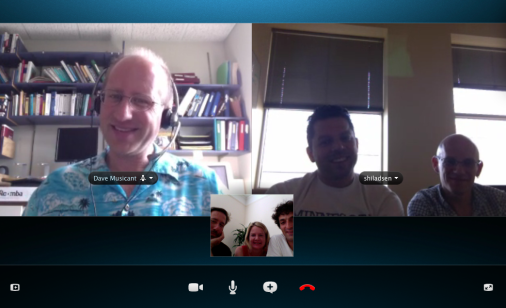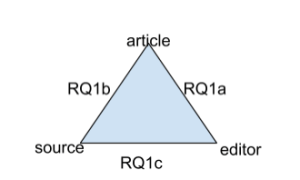22 Jul 2014
In this series of blog posts, Heather Ford documents the process by which a group of computer and social scientists are working together in a project to understand the geography of Wikipedia citations. Their aim is not only to better understand how far Wikipedia has come to representing ‘the sum of all human knowledge’ but to do so in a way that lays bare the processes by which ‘big data’ is selected and visualized. In this post, Heather discusses how the group are focusing their work on a series of exploratory research questions.
In last week’s call, we had a conversation about articulating the initial research questions that we’re trying to answer. At it’s simplest level, we decided that what we’re interested in is:
‘How much information about a place on Wikipedia comes from that place?’
In the English Wikipedia article about Guinea Bissau, for example, how many of the citations originate from organisations or authors in Guinea Bissau? In the Spanish Wikipedia article about Argentina, for example, what proportion of editors are from Argentina? Cumulatively, can we see any patterns among different language versions that indicate that some language versions contain more ‘local’ voices than others?
We think that these are important questions because they point to extent to which Wikipedia projects can be said to be a reflection of how people from a particular place see the world; they also point to the importance of particular countries in shaping information about certain places from outside their borders. We think it makes a difference to the content of Wikipedia that the US’s Central Intelligence Agency (CIA) is responsible for such a large proportion of the citations, for example. Past research from Brendan Luyt and Tan (2010, PDF) is instructive here. In 2010, Luyt and Tan took a random sample of national history articles on Wikipedia (English) and found that 17% were government sites and of those 17%, four of the top five sites were US government sites including the US Department of State and the CIA World Fact Book. The authors write that this is problematic because ‘the nature of the institutions producing these documents makes it difficult for certain points of view to be included. Being part of the US government, the CIA World Fact Book, for example, is unlikely to include a reading of Guatemalan history that stresses the role of US intervention as an explanation for that country’s long and brutal civil war.’ (p719)
Instead of Luyt and Tan’s history articles, we’re looking at country articles and we’re zeroing in on citations and trying to ‘locate’ those citations in different ways. While we were talking on Skype, Shilad drew this really great diagram to show how we seem to be looking at this question of information geography:
In this research, we seem to be looking at locating all three elements (the location of the article, the sources/citations and the editors) and then establishing the relationships between them i.e.
RQ1a What proportion of editors from a place edit articles about that place?
RQ1b What proportion of sources in an article about a place come from that place?
RQ1c What proportion of sources from particular places are added by editors from that place?
We started out by taking the address of the administrative contact contained in a source’s domain registration as the signal for the source’s location but we’ve come up against a number of issues as we’ve discussed the initial results. A question that seems to be a precursor to the questions above seems to be how we define ‘location’ in the context of a citation contained within in an article about a particular place. There are numerous signals that we might use to associate a citation with a particular place: the HQ of the publisher, for example, or the nationality of the author; the place in which the article/paper/book is set, or the place in which the publishers are located. An added complexity has to do with the fact that websites sometimes host content produced elsewhere. Are we using ‘author’ or ‘publisher’ when we attempt to locate a citation? If we attribute the source to the HQ of the website and not the actual text, are we still accurately portraying the location of the source?
In order to understand which signals to use in our large scale analysis, then, we’ve decided to try to get a better understanding of both the shape of these citations and the context in which those citations occur by looking more closely at a random sample of citations from articles about places and asking the questions:
RQ0a To what extent might signals like ‘administrative contact of the domain registrant’ or ‘country domain’ accurately reflect the location of authors of Wikipedia sources about places?
RQ0b What alternative signals might more accurately capture the locations of sources?
Already in my own initial analysis of the English Wikipedia article on Mombasa, I noticed that citations to some articles written by locals were hosted on domains such as wordpress.com and wikidot.com that are registered in the US and Poland respectively. There was also a citation to the Kenyan 2009 census authored by the Kenya National Bureau of Statistics hosted by Scribd.com, and a link to an article about Mombasa written by a Ugandan on a US-based travel blog. All this means that we are going to under-represent East Africans’ participation in the writing of this place-based article about Mombasa if we use signals like domain registration.
We can, of course, ‘solve’ each of these problems by removing hosting sites like WordPress from our analysis, but the concern is whether this will negatively affect the representation of efforts by those few in developing countries who are doing their best to produce local content on Wikipedia. Right now, though, we’re starting with the micro level instances and developing a deeper understanding that way, rather than the other way around. And that I really appreciate.

